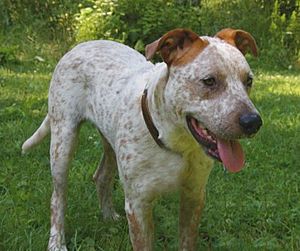Bull Arab facts for kids
 |
|||||||||||||||||
| Origin | Australia | ||||||||||||||||
|---|---|---|---|---|---|---|---|---|---|---|---|---|---|---|---|---|---|
| Breed status | Not recognised as a standardised breed by any major kennel club. | ||||||||||||||||
|
|||||||||||||||||
| Domestic dog (Canis lupus familiaris) | |||||||||||||||||
The Bull Arab is a special type of dog. It was first developed in Australia. People created this dog to help with hunting wild pigs.
These dogs were made by mixing several large, strong breeds. Some of the main dogs used were Bull Terriers, Great Danes, Greyhounds, and Mastiffs. The goal was to create a medium to large-sized dog. It needed to be muscular and have short fur.
Bull Arabs were originally bred for hunting feral pigs. They were developed to find pigs, pull them to the ground, and hold them by the ear. These dogs are very good at smelling. They can find pigs as far as 4 to 6 kilometers (about 2.5 to 3.7 miles) away!
What are Bull Arabs Like?
Bull Arabs usually have a calm nature. They are also very smart and easy to train. People know them for being loyal and loving towards people.
Sometimes, Bull Arabs get a reputation for being aggressive. However, groups like RSPCA Australia say this is often because of how the media or public see them. While some incidents have been linked to this breed, councils like the Mackay Regional Council say it's not more often than with other dog breeds.
It is believed that problems often come from how the dogs are raised. If dogs are not socialized well, they might act out. This means they need to learn how to be around other people and animals. Bull Arabs are also used as companion dogs and even therapy animals. This shows they can be gentle and helpful.
Why are Some Bull Arabs Abandoned?
Sadly, many large dogs, including Bull Arabs, are sometimes abandoned. This happens a lot in Queensland, Australia. One reason is that many rental homes there do not allow large dog breeds.
RSPCA Australia also says that some pig hunters do not spay or neuter their dogs. This leads to many puppies being born. Sometimes, these litters of puppies are then left without homes.

